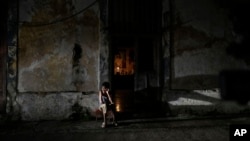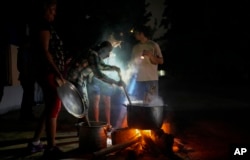Many Cubans waited in anguish Sunday as electricity on much of the island had yet to be restored days after an island-wide blackout. Their concerns were also raised as Hurricane Oscar made landfall in the southeastern Bahamas and was heading toward their country.
Some neighborhoods had electricity restored in Cuba’s capital, where 2 million people live, but most of Havana remained dark. The impact of the blackout goes beyond lighting, as services like water supply also depend on electricity to run pumps.
People resorted to cooking with improvised wood stoves on the streets before the food went bad in refrigerators.
In tears, Ylenis de la Caridad Napoles, mother of a 7-year-old girl, says she is reaching a point of “desperation.”
The failure of the Antonio Guiteras plant on Friday, which caused the collapse of the island's whole system, was just the latest in a series of problems with energy distribution in a country where electricity has been restricted and rotated to different regions at different times of the day.
People lined up for hours on Sunday morning to buy bread in the few bakeries that could reopen.
Some Cubans like Rosa Rodríguez have been without electricity for four days.
“We have millions of problems, and none of them are solved,” said Rodríguez. “We must come to get bread, because the local bakery is closed, and they bring it from somewhere else.”
Cuba's energy minister Vicente de la O Levy was expected to speak at a press conference on Sunday.
About half of Cuba was plunged into darkness on Thursday evening, followed by the entire island on Friday morning after one of the plants failed.
Besides the Antonio Guiteras plant, whose failure on Friday affected the entire national system, Cuba has several others, and it wasn’t immediately clear whether they remained functional.
The blackout was considered to be Cuba’s worst in two years after Hurricane Ian made landfall as a Category 3 storm in 2022 and damaged power installations. It took days for the government to fix them. This year, some homes have spent up to eight hours a day without electricity.
Cuba’s government said on Saturday that some electricity had been restored after one of the country’s major power plants failed. But the 500 megawatts of energy in the island’s electricity grid, far short of the usual 3 gigawatts it needs, had quickly decreased to 370 megawatts.
There is no official estimate for when the blackout will end. Even in a country that is used to outages as part of a deepening economic crisis, Friday’s collapse was massive.
The Cuban government has announced emergency measures to slash electricity demand, including suspending school and university classes, shutting down some state-owned workplaces and canceling nonessential services.
Local authorities said the outage stemmed from increased demand from small- and medium-sized companies and residential air conditioners. Later, the blackout got worse because of breakdowns in old thermoelectric plants that haven’t been properly maintained, and the lack of fuel to operate some facilities.
Later, Cubans grew more concerned after Oscar made landfall in the Bahamas. The National Hurricane Center in Miami said the storm’s center arrived on Great Inagua island.
Forecasters said five to 10 inches of rain are expected across eastern Cuba through Tuesday, with some isolated locations getting up to 15 inches.
Oscar formed Saturday off the coast of the Bahamas and brushed past the Turks and Caicos islands to the south.
The hurricane center earlier characterized the storm as “tiny,” but hurricane warnings were in place Sunday for southeastern Bahamas and portions of Cuba.
The storm’s maximum sustained winds were clocked at 80 mph (130 kph) with higher gusts. Its center was located about 150 miles (240 kilometers) east-northeast of Guantanamo, Cuba. The storm was heading west at 12 mph (19 kph) and was expected to reach Guantanamo or Holguin, Cuba, on Sunday afternoon at hurricane strength.









